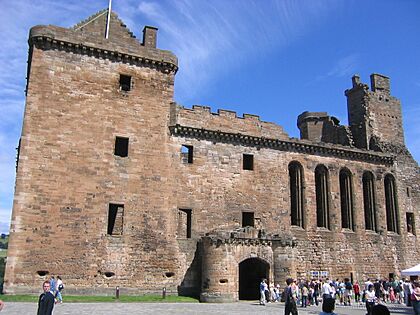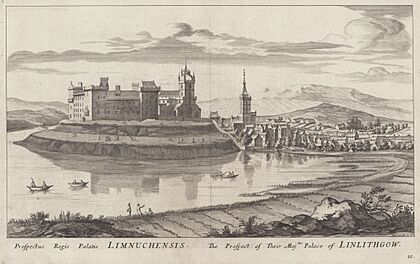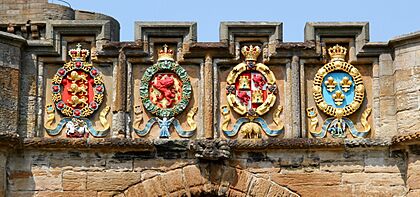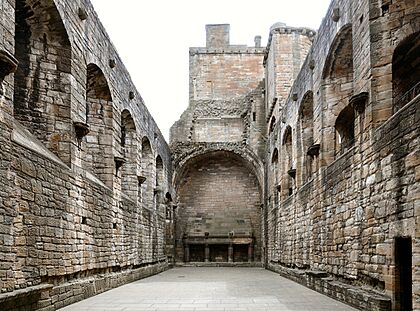Linlithgow Palace facts for kids
The ruins of Linlithgow Palace are in the town of Linlithgow, West Lothian, Scotland, about 15 miles west of Edinburgh. For centuries, this palace was a favorite home for the kings and queens of Scotland.
The palace was a grand residence in the 1400s and 1500s. After the Scottish monarchs moved to England in 1603, it was not used as much. In 1746, a great fire destroyed much of the palace. Today, it is a popular tourist attraction cared for by Historic Environment Scotland.
Contents
How the Palace Began
A royal house has stood on this spot since the 1100s. In the early 1300s, English soldiers led by King Edward I took over the site. They built a wooden fort surrounded by a ditch. This type of fort was called a 'Peel'. It was a perfect spot to control the routes between Edinburgh Castle and Stirling Castle.
A Clever Plan to Recapture the Fort
In 1313, the Scots took back the fort with a clever trick. A local farmer named William Bynnie, who often sold hay to the English soldiers, came to the gate with his wagon.
When the soldiers opened the gate, Bynnie stopped his wagon right in the entrance so the gate couldn't be closed. He and his seven sons, who were hiding under the hay, jumped out and captured the fort for the Scottish King, Robert the Bruce. King Robert later had the fort taken down so the English couldn't use it again.
From Fort to Palace
In 1424, a huge fire destroyed much of the town of Linlithgow. King James I decided to rebuild the site not as a fort, but as a beautiful palace for Scottish royalty. He was inspired by grand palaces he had seen in England. He also started rebuilding the nearby Church of St Michael.
Over the next 100 years, kings like James III and James IV added more to the palace, turning it into the grand courtyard structure we see today.
A Home for Kings and Queens
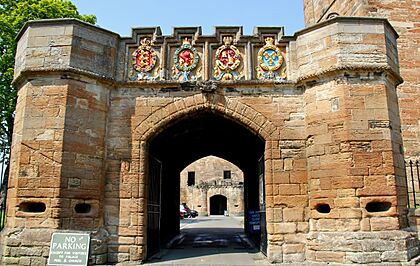
James IV and Queen Margaret Tudor
King James IV loved Linlithgow Palace. He often gave tips, called "drinksilver", to the workers building the palace. The palace was a lively place with parties, plays, and games like dice and cards.
In 1503, James IV gave the palace to his new wife, Margaret Tudor. It quickly became her favorite home in Scotland. Their son, the future King James V, was born in the palace in 1512. The queen's household included servants from Africa, named Margaret and Ellen More.
James V and the Grand Fountain
When James V grew up, he made his own mark on the palace. He added the impressive outer gateway and the famous fountain in the center of the courtyard. The fountain was very elaborate and a wonder of its time.
James V's wife, Mary of Guise, also lived at the palace. The court enjoyed entertainment, including an early version of a famous Scottish play, A Satire of the Three Estates, which was performed in the Great Hall.
Birthplace of a Famous Queen
Mary, Queen of Scots, was born at Linlithgow Palace in December 1542. As a baby, she was cared for in her mother's rooms. An English ambassador, Ralph Sadler, visited and wrote that Mary was "as goodly a child I have seen."
Because of political dangers, the infant queen was moved from Linlithgow to the safer Stirling Castle when she was only seven months old. As an adult, Queen Mary often visited the palace, and her husband, Henry Stuart, Lord Darnley, enjoyed playing tennis there.
The Palace in Later Years
King James VI
After Mary, Queen of Scots, her son James VI of Scotland became king. He held a parliament meeting in the palace's Great Hall in 1585. He gave the palace to his wife, Anne of Denmark, as a wedding gift. Their daughter, Princess Elizabeth, lived in the palace as a child.
In 1603, James VI also became King of England and moved his court to London. This event was called the Union of the Crowns. After this, the Scottish royal family spent very little time at Linlithgow.
Damage and Rebuilding
Because it was no longer used, the palace began to fall apart. In 1607, the entire north section of the palace collapsed. King James ordered it to be rebuilt between 1618 and 1622. The new building was very stylish, with beautiful stone carvings.
Despite the repairs, the only king to stay at Linlithgow after this was Charles I, who spent one night there in 1633.
The Great Fire of 1746
The palace's final chapter as a royal home came in 1745. Bonnie Prince Charlie visited on his march through Scotland. It is said that to celebrate his visit, the courtyard fountain was made to flow with wine.
A few months later, in February 1746, government soldiers were staying in the palace. They accidentally started a fire by leaving lamps on straw bedding. The fire spread quickly and destroyed most of the palace, leaving it the ruin we see today.
Linlithgow Palace Today
For many years, the palace was neglected. In the 1800s, the government began to take care of it. Today, Historic Environment Scotland manages the site.
The palace is open to visitors all year. You can explore the ruins, see the famous fountain, and imagine what life was like for the kings and queens who lived there. The palace is said to be haunted by the ghost of Mary of Guise, who watches from the windows.
The palace has also been used for modern events. In 2012, the fashion brand Chanel held a show inside the ruins. It has also been used as a filming location for the TV series Outlander, which has made it even more popular with tourists from around the world.
Images for kids
-
St Michael's Church with its modern spire, seen from the palace.
-
Linlithgow Palace by the famous artist J.M.W. Turner, painted in 1807.
See also
 In Spanish: Palacio de Linlithgow para niños
In Spanish: Palacio de Linlithgow para niños


